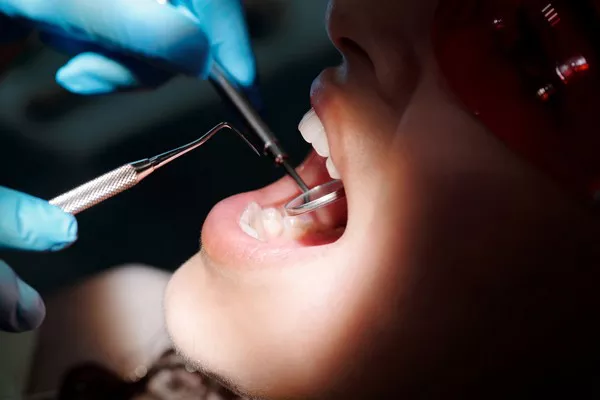Gingivitis is a common and mild form of periodontal disease (gum disease) that manifests as inflammation of the gums. It is primarily caused by the accumulation of plaque, a sticky film of bacteria that forms on teeth. Plaque formation is an inevitable part of daily life and oral activity; however, without proper oral hygiene, it can harden into tartar, which exacerbates the condition. The primary symptoms of gingivitis include redness, swelling, and bleeding of the gums, especially during brushing or flossing. Although gingivitis is generally painless and can be mild in its early stages, it serves as a critical warning sign for more severe gum disease if left untreated.
Gingivitis arises when plaque is allowed to accumulate on the teeth and gums. Plaque contains bacteria that produce toxins, leading to irritation and inflammation of the gum tissue. Contributing factors include poor oral hygiene, smoking or chewing tobacco, diabetes, certain medications, hormonal changes (such as during pregnancy), and genetic predisposition. In some cases, underlying systemic conditions can also increase the risk of developing gingivitis.
Connection to Tooth Sensitivity
Tooth sensitivity, or dentin hypersensitivity, refers to discomfort or pain in the teeth in response to certain stimuli, such as hot, cold, sweet, or acidic foods and beverages. The connection between gingivitis and tooth sensitivity lies primarily in the condition’s impact on the gums. Gingivitis causes the gums to become inflamed and, if untreated, can lead to the gums pulling away or receding from the teeth. This recession exposes the tooth roots, which are not covered by the protective enamel and are thus more vulnerable to external stimuli.
When the gums recede, the dentin layer of the tooth, which contains tiny tubules leading to the nerve, becomes exposed. These tubules allow stimuli such as temperature changes to reach the nerve more easily, resulting in the sharp pain characteristic of tooth sensitivity. Therefore, while gingivitis itself does not directly cause tooth sensitivity, its progression and the resulting gum recession can lead to increased sensitivity in affected teeth.
Causes of Sensitivity
The root cause of tooth sensitivity in the context of gingivitis is the exposure of the dentin layer. Dentin is the porous, bone-like tissue beneath the enamel and cementum. It contains microscopic tubules that communicate with the nerve endings inside the tooth. When these tubules are exposed due to gum recession, triggered by the inflammation and tissue destruction from gingivitis, they allow heat, cold, sweet, or acidic stimuli to reach the nerves, causing sharp, transient pain.
Several mechanisms contribute to this exposure:
Gum Recession: As mentioned, the inflammation from gingivitis causes the gums to recede from the teeth. This recession exposes the root surfaces of the teeth, which lack the enamel protection present on the crowns of teeth.
Loss of Protective Barriers: The roots of teeth are covered by cementum, a calcified layer that is thinner and less protective than enamel. When gingivitis progresses, this cementum can be worn away, further exposing the dentin underneath.
Plaque and Tartar Buildup: The bacteria in plaque and tartar release toxins that irritate and inflame the gums. Over time, the continued presence of these irritants can erode both the gum tissue and the underlying tooth structures, making sensitivity more likely.
Exacerbating Factors: Other factors that can worsen the sensitivity include aggressive brushing, which can wear away the gum line and tooth structure, as well as acidic foods and beverages that can erode the enamel and cementum, leading to increased dentin exposure.
Symptoms of Tooth Sensitivity
Tooth sensitivity can manifest in several ways, typically characterized by sharp, sudden pain in response to specific triggers. Common symptoms include:
Pain with Temperature Changes: Sharp pain when consuming hot or cold foods and beverages is a hallmark symptom of tooth sensitivity. The exposed dentin allows thermal stimuli to reach the nerves quickly.
Pain with Sweet or Acidic Foods: Similar sharp pain can occur when eating sweets or acidic foods. These substances can penetrate the dentin tubules and irritate the nerves.
Discomfort with Brushing and Flossing: The exposed dentin can also cause pain during routine oral hygiene practices, such as brushing and flossing, particularly if done with too much force or with abrasive toothpaste.
Occasional, Spontaneous Pain: Sometimes, tooth sensitivity can cause spontaneous pain without an obvious trigger, although this is less common than pain caused by direct stimuli.
Prevention and Treatment
Preventing gingivitis and the associated tooth sensitivity involves maintaining good oral hygiene practices and seeking regular dental care. Here are several strategies to prevent and treat these conditions:
Proper Brushing Technique: Use a soft-bristled toothbrush and fluoride toothpaste to brush teeth at least twice a day. Be gentle to avoid damaging the gums and tooth enamel.
Regular Flossing: Floss daily to remove plaque and food particles from between the teeth and along the gum line. This helps prevent plaque buildup and gum inflammation.
Professional Cleanings: Regular dental check-ups and professional cleanings are crucial. Dentists can remove tartar that regular brushing and flossing cannot, reducing the risk of gingivitis.
Mouthwash: Use an antimicrobial mouthwash to reduce bacteria in the mouth and help prevent gum disease.
Dietary Considerations: Reduce the intake of sugary and acidic foods and beverages that can contribute to plaque buildup and tooth erosion.
Treating Existing Sensitivity: For those already experiencing sensitivity, desensitizing toothpaste can help. These toothpastes contain compounds that help block the transmission of sensation from the tooth surface to the nerve.
Fluoride Treatments: Dentists can apply fluoride varnishes or gels to the teeth to help strengthen enamel and reduce sensitivity.
Sealants and Bonding Agents: In some cases, dentists may apply sealants or bonding agents to cover exposed dentin and protect sensitive areas of the teeth.
When to Consult a Dentist
It is important to see a dentist if you experience persistent tooth sensitivity or any signs of gingivitis, such as red, swollen, or bleeding gums. Early intervention can prevent the progression of gingivitis to more severe forms of periodontal disease and help manage and reduce tooth sensitivity.
Consulting a dentist is crucial when:
Persistent Sensitivity: If tooth sensitivity persists despite using desensitizing toothpaste and other home remedies, a dentist can provide more targeted treatments.
Signs of Gum Disease: Bleeding, swollen, or receding gums are signs of gingivitis or more severe gum disease. Prompt treatment can prevent further damage.
Pain: Any persistent pain in the teeth or gums should be evaluated by a dentist to determine the underlying cause and appropriate treatment.
Changes in Oral Health: Any noticeable changes in oral health, such as loose teeth or changes in the fit of dentures, should be addressed promptly to prevent further complications.
Conclusion
Gingivitis, a common and preventable form of gum disease, can significantly impact oral health if left untreated. One of the potential consequences of untreated gingivitis is tooth sensitivity, resulting from gum recession and exposure of the dentin layer of the teeth. Understanding the connection between gingivitis and tooth sensitivity highlights the importance of maintaining good oral hygiene practices and seeking regular dental care. By doing so, individuals can prevent the onset of gingivitis, manage tooth sensitivity, and maintain overall oral health. If symptoms of gingivitis or persistent tooth sensitivity occur, consulting a dentist promptly can ensure appropriate treatment and prevent further complications.
FAQs about Gingivitis and Tooth Sensitivity
1. Does gingivitis make your teeth hurt?
Gingivitis itself typically does not cause tooth pain directly. It is an inflammation of the gums, characterized by redness, swelling, and bleeding, especially during brushing or flossing. However, if left untreated, gingivitis can progress to periodontitis, a more severe form of gum disease that can lead to tooth pain due to the destruction of the supporting structures of the teeth, such as the bone and ligaments.
2. Why is my tooth sensitive all of a sudden?
Sudden tooth sensitivity can be caused by a variety of factors:
Tooth Decay: Cavities expose the inner layers of the tooth, leading to sensitivity.
Gum Recession: This exposes the sensitive root surface.
Enamel Erosion: Acidic foods and drinks can wear away enamel, making teeth more sensitive.
Recent Dental Procedures: Treatments like fillings, crowns, or teeth whitening can temporarily increase sensitivity.
Cracked Tooth: A crack can expose the dentin or pulp, causing sensitivity.
Gum Disease: Inflammation from gingivitis or periodontitis can cause sensitivity due to gum recession and exposure of the tooth roots.
3. Are teeth sensitive with gum disease?
Yes, teeth can become sensitive with gum disease. As gum disease progresses, the gums may recede, exposing the tooth roots, which are not covered by protective enamel. This exposure can make teeth more sensitive to temperature changes, acidic foods, and even touch. Additionally, the inflammation and infection associated with advanced gum disease can exacerbate this sensitivity.
4. What happens to your teeth when you have gingivitis?
When you have gingivitis, several changes occur in your oral health:
Inflamed Gums: Gums become red, swollen, and bleed easily, especially during brushing and flossing.
Plaque Buildup: The primary cause of gingivitis is the accumulation of plaque, a sticky film of bacteria on the teeth.
Tartar Formation: If plaque is not removed, it hardens into tartar, which can only be removed by a dental professional.
Receding Gums: Over time, the inflammation can cause gums to pull away from the teeth, creating pockets where more bacteria can gather.
Potential Progression to Periodontitis: If untreated, gingivitis can advance to periodontitis, leading to the destruction of the bone and tissues that support the teeth, potentially causing tooth loss.
You Might Be Interested In






























